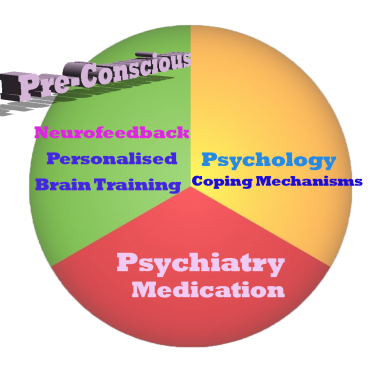
Depression. Can. be. Resolved.
Neurofeedback Training can be applied to have a significant anti-depressant effect, promoting cheerfulness and positivity, and stabilising mood swings in Bipolar Disorder. There are many ways to alleviate symptoms, from exercise and a healthy diet, to structuring one's day to stay busy, finding competitive goals and working towards them, and of course psychotherapy with its drug-focused approach. While useful, and in part very effective, none of these address the fundamental issue, which is a lack of healthy self-regulation in the brain.
Neurofeedback takes aim at precisely this: encouraging the brain to find its optimal pattern of self-regulation, enabling us to stay calm and focused, put a constructive distance between us and the world around us while being able to engage with issues, friends, family, work and performance.
Neurofeedback can help Regulate Energy and Emotions
Mood regulation is an issue for most people, even when there is no diagnosable disorder. Neurofeedback training can be very effective at targeting various symptoms:
- calming the body, thus helping body awareness and feeling more grounded in the body
- calming core emotions and quietening emotional reactivity, fear and anger, hypervigilance and paranoia
- calming conscious worry, reducing obsessive thoughts, compulsive behaviours, and strengthening a core sense of self-worth
- stabilising mood swings by calming core emotional misery, whether overwhelm and despair, anger and range
- stabilising against panic attacks, going beyond baseline anxiety and helping prevent discrete events in which the brain goes out of control
- restoring optimism, promoting cheerfulness and the ability to plan for the future
Many of the following conditions have one or more of the above symptoms, which neurofeedback seeks to address:
- ADHD
- Addiction
- Anxiety
- Anger Management Issues
- Attachment Disorder
- Bipolar Disorder
- Depression
- Insomnia
- Learning Disabilities
- OCD and Obsessive Thinking
- PTSD (Post Traumatic Stress Disorder)
It is also beneficial in restoring mental health and emotional wellbeing following seizures, strokes and Traumatic Brain Injury (TBJ)
It is useful in trauma, as this report of a patient who is now able to fully describe her condition illustrates:
“It calmed me down. I can now use my feelings, and I don’t seem to be running away from them, nor held in their throes. I don’t feel like I am dissociating, I feel more ‘me’, more there, more in the moment.
Anxiety is not running my life anymore. It’s still there at times, but not all the time and when it is, I am aware of it. I can reflect on things that happened, that hurt me, and I’m not scared to think about them – they don’t drag me down anymore. I’ve gained a healthy emotional distance and my life is taking the direction I want it to.
Neurofeedback freed me up to live my life the way I want to because I’m not always in the thrall of how I was hurt and what it did to me.
I’m not in fight or flight physically all the time.”
Here‘s an article on how neurofeedback helps regulate energy and emotions.
Neurofeedback is a form of complementary therapy and should not be seen as a replacement for conventional medicine. qEEG brain map-based neurofeedback training takes a more holistic approach to brain functioning, rather than just focusing on medical symptoms. It is not intended as a form of diagnosis nor medical intervention nor medical advice per the disclaimer.
Brain Maps and Personalised Brain Training Explained
Personalised Brain Training with Neurofeedback
Neurofeedback lets us train dysrythmic brain areas. With sensors comfortably fitted to the brain areas we want to train, we detect brainwave patterns real-time while watching a movie. When these patterns are inefficient, the volume drops momentarily. This is the feedback we are giving our brain, short and instantaneously.
The brain area we are training recognises this – while our conscious mind is focussed on the movie – and adjusts its behaviour to restore the normal volume. With repetition, throughout a session, learning occurs.
Meanwhile our conscious mind is solely focussed on the movie; the training process is passive in this sense.
The drop in volume is subtle, so we continue to understand the flow of the movie. No current or electrical stimulation is fed to the brain; sensors simply read brainwaves and the feedback is purely audio-visual.

Neurofeedback trains our Pre-Conscious Mind
Rather than engaging the conscious mind, which slows us down, we are training preconscious processes.
This equips us with the ability to live in the moment and attain our potential (if we have to resort to conscious control, we are not living in the moment).
We take a holistic approach to healthy brain self-regulation, rather than categorisation or diagnosis.
Personalised Brain Training is an advanced qEEG brain map-based approach to neurofeedback training developed by the founders of the field. Taking Othmer Method / ILF training methods further, it employs Default Network Training protocols as developed by David Kaiser.

Neurofeedback is Evidence-based
Neurofeedback training is an evidence-based complementary therapy. Its efficacy was first demonstrated some 50 years ago, and with advances in technology, training protocols have become more efficient and the feedback method – watching movies – thoroughly enjoyable.
Neurofeedback is evidence-based. It’s first application was discovered in 1971 when it was used to resolve intractable epilepsy.
There are over 2,000 peer-reviewed research reports on PubMed demonstrating efficacy across a number of pathologies.
In the US, it is an accepted complementary treatment for many challenges.